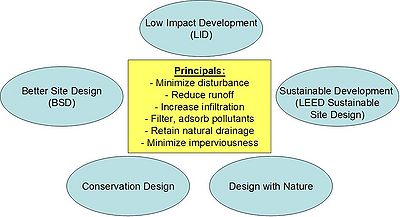
Credits for Better Site design
The six better site design approaches that could be eligible for water quality volume reduction stormwater credits include
- natural area conservation;
- site reforestation or prairie restoration;
- drainage to stream or shoreline buffers;
- surface impervious cover disconnection;
- rooftop disconnection; and
- use of grass channels.
For consistency with other sections of this Manual, the formulas for computing water quality volumes and related credits are based on the requirements contained in the MPCA Construction General Permit (CGP). These formulas provide just one option for local authorities to consider. The approach used in these examples subtracts the credit volume from the water quality volume (Vwq); the volume of a permanent pool (Vpp) in a stormwater pond or wetland is not adjusted. Other options that could be considered include applying credits to Vpp, or proportional application of a credit to both Vpp and Vwq.
It is not the intention of this system of credits to eliminate the need for a water quality volume. It is possible that the area proposed for conservation exceeds the area proposed as impervious surface. In this circumstance, it is recommended that a minimum water quality volume equal to 0.2 watershed inches be maintained (see Unified sizing criteria).
Local authorities should keep in mind that the current MPCA CGP, which expires in 2008, does not incorporate a technique for application of these credits. This CGP does allow up to a maximum of 1 percent of a site, up to 3 acres to drain untreated to natural areas, in sites where any BMP is not feasible.
Although stormwater credits are not currently used under the Minnesota Pollution Control Agency Construction General Permit (CGP), they can be applied at the local and watershed levels to supplement the CGP or be used for projects not covered under the CGP. Credits can also be used as part of the financial evaluation under a local stormwater utility program. Further evaluation of the use of credits in the CGP process will occur as part of the permit update process.
Although not explicitly allowed under the current MPCA CGP, there are situations where a local authority could create a water quality credit system which does not conflict with the CGP. For example, a local authority that requires a water quality volume that is greater than the CGP water quality volume, could apply credits against the difference between the two volumes. Another situation appropriate for credits could be retrofit projects that do not create new impervious surfaces. These projects are not subject to permanent stormwater management requirements of the CGP. Local authorities interested in establishing a credit system are encouraged to contact the MPCA to explore if the local proposal is compatible with the CGP.
The last section of this page presents tips on how to establish and administer a local stormwater credit system, with an emphasis on review and verification during concept design, final design and construction.
Contents
- 1 Better site design and stormwater credits
- 2 Stormwater credit categories
- 3 Establishing an effective local stormwater credit system
- 4 References[2]
- 5 Notes
Better site design and stormwater credits
There are more than a dozen better site design techniques that can be applied at development sites. When applied early in the design process, these techniques can dramatically reduce stormwater runoff and pollutants generated from development sites (CWP, 1999). In recent years, several states have sought to encourage greater use of better site design techniques by allowing for computation of stormwater credits that reduce the required water quality volume that must be provided at a development site.
Agencies that utilize stormwater credits can sharply reduce water quality and stormwater management BMP size requirements and recommendations. This translates directly into cost savings for developers since the size and cost of stormwater conveyance and treatment systems needed for the site are reduced, and less land area is needed for BMPs. The use of credits by developers is strictly voluntary, although they do offer a meaningful incentive to reduce the cost of stormwater compliance.
Stormwater credits are tied directly to the water quality volume requirements (Vwq and Vpp). In addition, credits can be used to reduce the storage volumes needed to manage larger storm events, such as any locally-required channel protection and overbank floods (by increasing times of concentrations and reducing curve numbers in post-development hydrological modeling). Not all credits will be available for each site, and certain site-specific conditions should be met to receive each credit. These minimum conditions include site factors such as maximum flow length or contributing area that avoid situations that could lead to runoff concentration and erosion. Stormwater credits do not relieve designers from the normal standard of engineering practice of safe conveyance and drainage design. Multiple credits can be used at a development site, although two credits cannot be taken for the same physical area of the site.
Summary of stormwater credits function illustrating how to calculate water quality volume, channel protection and overbank storm volumes for different Better Site Design credits.
Link to this table.
| Stormwater credit | Adjusted water quality volume | Channel protection and overbank storms |
|---|---|---|
| Natural area conservation | Subtract CA from site IC when computing Vwq | Adjust CN for CA to woods in good condition |
| Site reforestation/prairie restoration | Subtract 1/2 RA from site IC when computing Vwq | Adjust CN for RA to woods or prairie in fair condition |
| Streams and shoreline buffers | Subtract ADB from site IC when computing Vwq | Adjust CN for ADB to woods in good condition |
| Surface impervious cover and disconnection | Subtract DIA from site IC when computing Vwq | Adjust CN for DIA to grass in good condition. Adjust Tc |
| Rooftop disconnection | Subtract DRA from site IC when computing Vwq | Adjust CN for DIA to grass in good condition. Adjust Tc |
| Grass channels | Subtract GA from site IC when computing Vwq | Adjust Tc |
Note: Unless otherwise noted, all units below are measured in acres
- CA = combined area of all natural areas conserved at site
- RA – Total area of site reforestation or prairie restoration
- ADB – Total area draining to buffer with appropriate flow path distance
- DIA – Total area of surface impervious cover that can be effectively disconnected
- DRA – Aggregate rooftop area that can be effectively disconnected
- GA - total non-roadway area draining to swale (rooftop, yard and driveway)
- CN – Runoff curve number for area (units: dimensionless) (see Ch.8 and App. B)
- Tc – Time of Concentration (units: time)
Vwq – Water quality volume, as defined by relevant MPCA sizing rule - IC - Impervious area of site (acres)
Stormwater credit categories
Six credit categories are addressed in this section.
- Natural area conservation credit
- Site reforestation or prairie restoration credit
- Drainage to stream, wetland or shoreline buffer credit
- Surface impervious cover disconnection credit
- Rooftop disconnection credit
- Grass channel credit
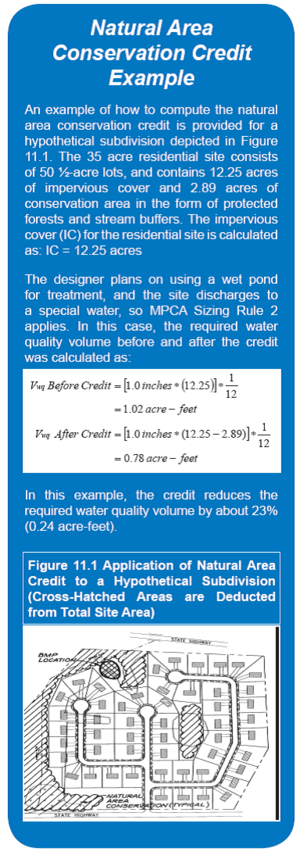
Natural area conservation credit
Natural area conservation protects natural resources and environmental features that help maintain the pre-development hydrology of a site by reducing runoff, promoting infiltration and preventing soil erosion. Natural areas should be eligible for stormwater credit if they remain undisturbed during construction and are protected by a permanent conservation easement prescribing allowable uses and activities on the parcel and preventing future development. Examples of conservation areas include any areas of undisturbed vegetation preserved at the development site, such as forests, prairies (native grasslands), floodplains and riparian areas, ridge tops and steep slopes, and stream, wetland and shoreline buffers. Floodplain credits should not be issued to areas that cannot be developed due to existing floodplain ordinance restrictions.
The undisturbed soils and native vegetation of conservation areas promote rainfall interception and storage, infiltration, runoff filtering and direct uptake of pollutants. Portions of the site devoted to natural area conservation are eligible for two credits, such as the addition of a buffer credit.
Water quality
The total combined area of all conservation areas can be subtracted from total site area when computing the water quality volume (Vwq) portion of the total storage volume. In the context of the four MPCA Vwq sizing rules, the credit is numerically expressed as:
Rule 1 (Stormwater Ponds and Constructed Wetlands):
Vwq=1815(IC−CA)
where:
- Vwq = required water quality volume in cubic feet;
- IC = new site impervious cover, in acres;
- CA = total natural area conserved at site, in acres; and
- 1815 = conversion factor (to cubic feet)
Rule 2 (Stormwater Ponds and Constructed Wetlands Draining to Special Waters) and Rule 3 (Non-Ponds):
Vwq=3630(IC−CA)
where:
- Vwq = required water quality volume in cubic feet;
- IC = new site impervious cover, in acres;
- CA = total natural area conserved at site, in acres; and
- 3630 = conversion factor (to cubic feet)
Larger storm events
The post-development curve number (CN) used to compute the Vcp, Vp10, and Vp100 for all natural conservation areas can be assumed to be “woods or prairie in good condition” when calculating the total site CN.
Conditions for credit
- The minimum combined area of all natural areas conserved at the site must exceed one acre. Full ecological function for natural grassland (prairie) begins at 5 acres and for forested land starts at 20 to 40 acres. Credits could be increased beyond 1:1 for acreages that approach and exceed these values.
- No disturbance may occur in the conservation area during or after construction (i.e., no clearing or grading except for temporary disturbances associated with incidental utility construction or restoration operations, or removal of nuisance vegetation).
- The limits of disturbance around each conservation area should be clearly shown on all construction drawings.
- A long-term vegetation management plan must be prepared to maintain the conservation area in a natural vegetative condition. Managed turf is not considered an acceptable form of vegetation management, and only the passive recreational areas of dedicated parkland are eligible for the credit (e.g., ball fields and golf courses are not eligible).
- The conservation area must be protected by a perpetual easement that clearly specifies that no future development or disturbance can occur within the area.
- The credit cannot be granted for natural areas already protected by existing federal, state, or local law.
- Conservation areas should be preserved to maximize contiguous area and avoid habitat fragmentation.
- Credits should be considered for establishing native plant community corridors or naturally vegetated connections between sites.
Site reforestation or prairie restoration credit
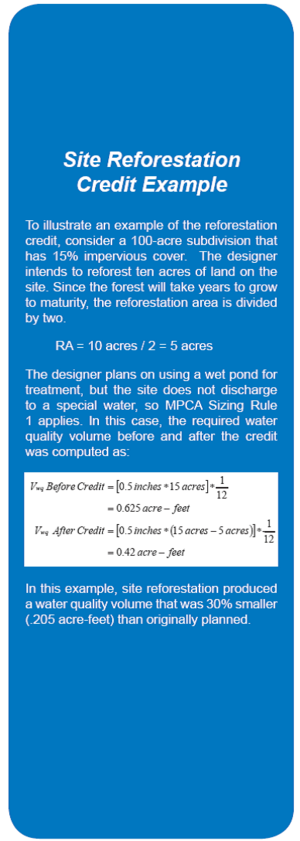
Site reforestation involves planting trees on existing turf or barren ground at a development site with the explicit goal of establishing a mature forest canopy that will intercept rainfall and maximize infiltration. Reforested or restored sites that are protected and maintained under a perpetual conservation easement should be eligible for a stormwater credit.
Reforestation is accomplished through active replanting or natural regeneration of forest cover. Capiella (2005) reviewed a range of research that demonstrated the runoff reduction benefits associated with forest cover compared to turf cover. The runoff benefits include greater infiltration of stormwater, reduced soil erosion, and removal of stormwater pollutants. Forest soils actively promote greater infiltration rates through surface organic matter and macropores created by tree roots. Forests also intercept rainfall in their canopy, reducing the amount of rain that reaches the ground. Evapotranspiration by trees increases potential water storage in the soil.
In some parts of the State, a native grassland (prairie) community is the desired vegetative condition. Since native grasslands have the same hydrological benefits as forest, the same credit is also offered for any prairie restoration conducted at a development site. Two types of credit (water quality and CN adjustment) are available for site reforestation or grassland restoration, which are computed as follows.
BMP guidance for Conserving Wooded Areas in Developing Communities was prepared by the Minnesota DNR in 2000.
Water quality
The combined total of all reforested or restored areas is divided by two to determine net reforestation area (RA). This is due to the fact that it will take several decades for the replanted area to mature and provide full hydrologic benefits. RA is then subtracted from total site area when computing the water quality volume (Vwq) portion of the total storage volume. In the context of the four MPCA Vwq sizing rules, the credit is numerically expressed as:
Rule 1 (Stormwater Ponds and Constructed Wetlands):
Vwq=1815(IC−RA)
where:
- Vwq = required water quality volume in cubic feet;
- IC = new site impervious cover, in acres;
- RA = total area reforested or restored at site, in acres; and
- 1815 = conversion factor (to cubic feet)
Rule 2 (Stormwater Ponds and Constructed Wetlands Draining to Special Waters) and Rule 3 (Non-Ponds):
Vwq=3630(IC−RA)
where:
- Vwq = required water quality volume in cubic feet;
- IC = new site impervious cover, in acres;
- RA = total area reforested or restored at site, in acres; and
- 3630 = conversion factor (to cubic feet)
Larger storm events
The post-development curve number (CN) used to compute the Vcp, Vp10, and Vp100 for the reforested area can be assumed to be “woods or prairie in fair condition” when calculating the total site CN, even if it will be decades before the forest reaches maturity.
Conditions for credit
- The minimum contiguous area of reforestation or prairie restoration must be greater than 20,000 square feet (i.e., no credit is granted for planting of individual street trees). Full ecological function for natural grassland (prairie) begins at 5 acres and for forested land starts at 20 to 40 acres. Credits could be increased beyond 1:1 for acreages that approach and exceed these values.
- A long-term vegetation management plan must be prepared and filed with designated authority to maintain the conservation area in either a natural forest or prairie condition.
- The conservation area must be protected by a perpetual easement that clearly specifies that no future development or disturbance can occur within the area.
- The method used for reforestation or restoration must achieve 75 percent forest canopy or prairie cover within ten years.
- The planting plan must be approved by the appropriate local stormwater, watershed or forestry agency, including any special site preparation needs.
- The construction contract should contain a care and replacement warranty extending at least three growing seasons to ensure adequate survival and growth of the plant community.
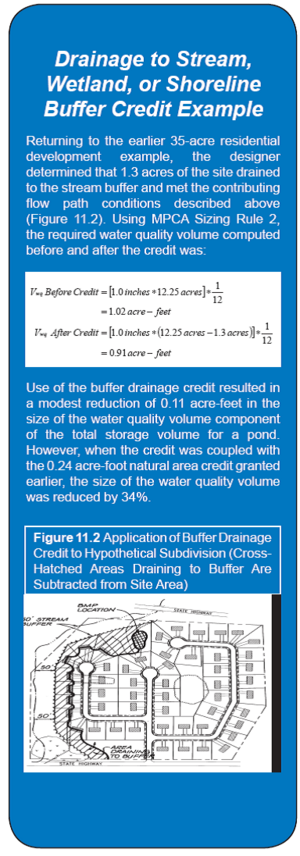
Drainage to stream, wetland or shoreline buffer credit
Buffers may be required at the development site to provide a vegetative setback between development and streams, lakes or wetlands. Portions of the site reserved as buffers and maintained in native vegetation can help filter stormwater runoff. While stream and shoreline buffers are already eligible for the natural area conservation credit, adjacent site area that directly contributes sheet flow to buffers may also be eligible for an additional credit.
In some cases, the outer boundary of the buffer may need to be modified to capture and treat overland flow from adjacent pervious and/or impervious areas by creating a shallow depression area or filter strip designed to maintain sheetflow conditions. The drainage to stream or shoreline buffer credit is computed as follows:
Water quality
The total area draining by sheet flow into the buffer from adjacent areas can be subtracted from total site area in the Vwq calculation portion of the total storage volume. The credit is numerically expressed for each of the four MPCA Vwq sizing rules using the following equations:
Rule 1 (Stormwater Ponds and Constructed Wetlands):
Vwq=1815(IC−ADB)
where:
- Vwq = required water quality volume in cubic feet;
- IC = new site impervious cover, in acres;
- ADB = total area draining to buffer, in acres; and
- 1815 = conversion factor (to cubic feet)
Rule 2 (Stormwater Ponds and Constructed Wetlands Draining to Special Waters) and Rule 3 (Non-Ponds):
Vwq=3630(IC−ADB)
where:
- Vwq = required water quality volume in cubic feet;
- IC = new site impervious cover, in acres;
- ADB = total area draining to buffer, in acres; and
- 3630 = conversion factor (to cubic feet)
Larger storm events
The post-development curve number (CN) used to compute the Vcp, Vp10, and Vp100 for the contributing buffer area can be assumed to be ”woods in good condition” when calculating the total site CN.
Conditions for credit
- The minimum acceptable buffer width for effective stormwater treatment is an average of 50 feet (minimum 25 feet), measured perpendicular to the stream, lake or wetland (averaging over the length of the buffer boundary is allowed).
- The maximum contributing flow path to the buffer may be no more than 150 feet for adjacent pervious cover and no more than 75 feet for adjacent impervious cover.
- The average contributing overland slope to and across the buffer must be less than 3 percent.
- Runoff should enter the outer boundary of the buffer as sheet flow, although a depression or level-spreading device may be used to spread out concentrated flow.
- The buffer credit may not be taken if either the rooftop or surface impervious cover disconnection credit has already been taken for the same contributing area (i.e., no double counting).
- Buffers should not be graded or compacted during construction
- Buffers should be maintained in a natural vegetative condition, with a long-term vegetative management plan.
- The area of the buffer itself may qualify as natural area conservation credit.
Additional sources of information on buffers can be found in Minnehaha Creek Watershed District (MCWD) (2001).
Surface impervious cover disconnection credit
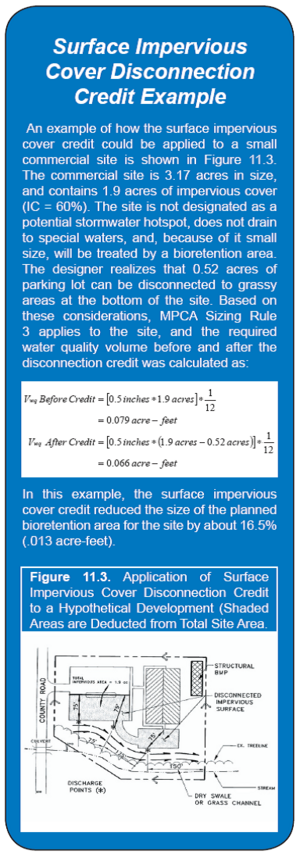
Surface disconnection spreads runoff from small parking lots, courtyards, driveways, sidewalks and other impervious surfaces into adjacent pervious areas where it is filtered or infiltrated. Note that rooftop disconnection is discussed in the next credits section. In most cases, the site is graded to divert sheet flow into a vegetated filter strip or pervious area for treatment. Disconnecting small areas of impervious cover from the storm drain system can greatly reduce the total volume and rate of stormwater runoff.
Credits for surface disconnection are subject to numerous restrictions concerning the length, slope, soil characteristics of the pervious area which are designed to prevent any reconnection of runoff with the storm drain system. In some cases, minor grading of the site may be needed to promote overland flow and vegetative filtering.
Two kinds of stormwater credit (water quality and CN adjustment) can be given for disconnecting surface impervious cover at a development site:
Water quality
The total disconnected impervious area (DIA) is subtracted from the total site area when computing the Vwq portion of the total storage volume. The following equations indicate how the credit is computed for the four MPCA sizing rules:
Rule 1 (Stormwater Ponds and Constructed Wetlands):
Vwq=1815(IC−DIA)
where:
- Vwq = required water quality volume in cubic feet;
- IC = new site impervious cover, in acres;
- DIA = total area of surface impervious cover effectively disconnected, in acres; and
- 1815 = conversion factor (to cubic feet)
Rule 2 (Stormwater Ponds and Constructed Wetlands Draining to Special Waters) and Rule 3 (Non-Ponds):
Vwq=3630(IC−DIA)
where:
- Vwq = required water quality volume in cubic feet;
- IC = new site impervious cover, in acres;
- DIA = total area of surface impervious cover effectively disconnected, in acres; and
- 3630 = conversion factor (to cubic feet)
Larger Storm Events (CN Adjustment)
The post-development curve number (CN) used to compute the Vcp, Vp10, and Vp100 for the area of disconnected impervious cover area can be assumed to be “grass in good condition” when calculating the total site CN.
Conditions for credit
The disconnection credit is subject to numerous conditions and restrictions, as outlined below:
- The contributing flow path from impervious cover should not exceed 75 feet.
- The recommended minimum length of the pervious area over which runoff is spread is 75 feet, and, in all cases, the disconnection length must exceed the contributing flow path.
- Compensatory storage may be needed for shorter disconnection lengths, in the form of a dry well, rain garden or spreading device.
- Pervious areas used for disconnection should have a slope no greater than 5 percent.
- The total surface impervious area contributing to any single discharge point shall not exceed 1,000 ft2 and shall drain continuously through a pervious filter strip until it reaches the property line or drainage swale
- No on-site soil evaluations are needed if the NRCS Soil Survey indicates soils are relatively permeable (e.g., Hydrologic Soil Groups A and B).
- On-site soil evaluations by an engineer, geologist or soil scientist are needed for less permeable soils (HSG C and D). Soil amendments may be needed to restore porosity of compacted pervious areas.
- Soil compost amendments may be required on pervious areas that will be utilized for either rooftop or surface disconnection that have soils in the C or D Hydrologic Soil Groups.
- Amendments can be applied to new lawns in residential subdivisions with lot sizes more than one-half acre in area , and at any other pervious area that is currently compacted or expected to become compacted in the future due to grading and construction activity.
- Soil amendment treatment used to enhance the disconnection properties of pervious areas should be a minimum of 5,000 square feet in surface area.
- Fiber type amendments are incorporated to maintain soil structure without compaction. These amendments are usually proprietary devices. Manufacturers should be contacted for specific recommendations.
- Soil amendments must meet minimum local specifications, such as Mn/DOT Technical Specifications #3890.
- If surface impervious cover ultimately drains to a stream buffer, the designer must choose either the surface disconnection credit or the stream buffer credit, but not both.
- The disconnection credit may not be used if the impervious cover is designated as a potential stormwater hotspot.
Guidance on storage-compensation rules for shorter disconnection lengths.
Link to this table.
| Disconnection length provided | 0 to 14 feet | 15 to 29 feet | 30 to 44 feet | 45 to 59 feet | 60 to 74 feet | 75 feet |
|---|---|---|---|---|---|---|
| % Vwq treated by disconnect | 0 | 20 | 40 | 60 | 80 | 100 |
| % runoff storage needed | 100 | 80 | 60 | 40 | 20 | 0 |
| Maximum storage volumea (ft3) | 40 | 32 | 24 | 16 | 8 | 0 |
aassuming 500 square feet roof area to each downspout disconnection
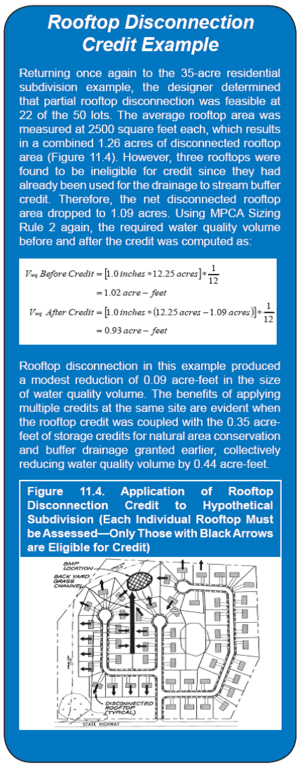
Rooftop disconnection credit
Disconnection of rooftops offers an excellent opportunity to spread rooftop runoff over lawns and other pervious areas where it can be filtered and infiltrated. Downspout disconnection can infiltrate runoff, reduce runoff velocity, and remove pollutants. Alternately, downspouts can be directed to a dry well, rain garden or surface depression. Stormwater credits could be offered for rooftop disconnections that effectively spread runoff over an acceptable pervious area that provides reasonable filtering and/or infiltration. In some cases, individual lots may need minor grading to meet minimum overland flow conditions. Two types of stormwater credits (water quality and CN adjusted) are possible for rooftop disconnections:
Water quality
The combined area of disconnected rooftops is subtracted from the total site area when computing Vwq as shown in the equations below:
Rule1 (Stormwater Ponds and Constructed Wetlands):
Vwq=1815(IC−GA)
where:
- Vwq = required water quality volume in cubic feet;
- IC = new site impervious cover, in acres;
- GA = non-roadway area draining to the swale, in acres; and
- 1815 = conversion factor (to cubic feet)
Rule 2 (Stormwater Ponds and Constructed Wetlands Draining to Special Waters) and Rule 3 (Non-Ponds):
Vwq=3630(IC−GA)
where:
- Vwq = required water quality volume in cubic feet;
- IC = new site impervious cover, in acres;
- GA = non-roadway area draining to the swale, in acres; and
- 3630 = conversion factor (to cubic feet)
Larger storm events (CN adjusted)
The post-development curve number (CN) used to compute the Vcp, Vp10, and Vp100 for the disconnected rooftops can be assumed to be grass in good condition when calculating the total site CN.
Conditions for credit
- The disconnections must address and adequately prevent any problems with basement seepage.
- Each individual rooftop must be assessed separately to determine if it can be effectively disconnected.
- The recommended length of pervious area over which rooftop runoff is spread should be at least 75 feet, and in all cases, the length of the disconnection should be equal to or greater than the contributing rooftop length.
- If shorter disconnection lengths are anticipated, then a runoff storage device such as a dry well or rain garden is needed, subject to storage-compensation rules.
- The contributing rooftop area to any single disconnected downspout cannot exceed 1,000 square feet.
- Disconnections are only credited for residential lot sizes exceeding 6,000 square feet.
- Pervious areas used for disconnection should have a slope no greater than 5 percent.
- Downspouts must be located at least 10 feet away from the nearest impervious surface to discourage re-connection with the storm drain system.
- In cases where gutter/downspout system are not used, rooftop runoff should drain as either sheetflow from the roof or drain to a subsurface drain field not directly connected to the drainage network.
- No on-site soil evaluations are needed if the NRCS Soil Survey indicates site soils are relatively permeable (e.g., Hydrologic Soil Groups A and B).
- On-site soil evaluations by an engineer, geologist or soil scientist are needed for less permeable soils (Hydrologic Soil Groups C and D). Soil compost amendments may be needed to recover soil porosity for compacted pervious areas.
- If the disconnected rooftop also drains directly to a stream buffer, designers must choose the rooftop disconnection credit or the stream buffer credit, but not both.
- If a rooftop is designated as a potential stormwater hotspot, the disconnected rooftop runoff may not commingle with any other runoff from any paved surfaces at the site.
Guidance on storage-compensation rules for shorter disconnection lengths.
Link to this table.
| Disconnection length provided | 0 to 14 feet | 15 to 29 feet | 30 to 44 feet | 45 to 59 feet | 60 to 74 feet | 75 feet |
|---|---|---|---|---|---|---|
| % Vwq treated by disconnect | 0 | 20 | 40 | 60 | 80 | 100 |
| % runoff storage needed | 100 | 80 | 60 | 40 | 20 | 0 |
| Maximum storage volumea (ft3) | 40 | 32 | 24 | 16 | 8 | 0 |
aassuming 500 square feet roof area to each downspout disconnection
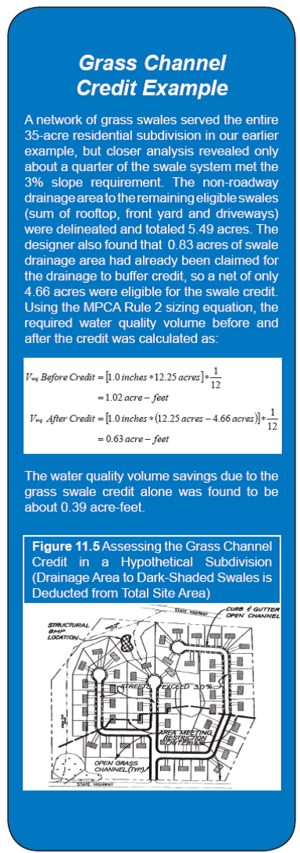
Grass channel credit
Curbs, gutters and storm drains are all designed to be hydraulically efficient in removing stormwater from a site. However, they also increase peak runoff discharge, flow velocity, and the pollutant delivery to downstream waters. Grass channels are preferable to curb and gutters as a conveyance system, where development density, topography, soils and slopes permit. While research has not demonstrated that grass channels remove pollutants reliably enough to qualify as a BMP (Winer, 2000), they have been shown to reduce runoff volumes during smaller storms when compared to curbs and gutters. Stormwater credits are provided for certain grass channel designs, based on their ability to reduce runoff volume through infiltration and soil filtration. Two credits (water quality and CN adjusted) can be applied when grass swales are used at a site:
Water quality
The non-roadway portion of the area draining to the swale can be subtracted from the total site area when computing Vwq portion of the total storage volume using the following equations:
Rule 1 (Stormwater Ponds and Constructed Wetlands:
Vwq=1815(IC−DRA)
where:
- Vwq = required water quality volume in cubic feet;
- IC = new site impervious cover, in acres;
- DRA = total area of disconnected rooftops, in acres; and
- 1815 = conversion factor (to cubic feet)
Rule 2 (Stormwater Ponds and Constructed Wetlands Draining to Special Waters) and Rule 3 (Non-Ponds):
Vwq=3630(IC−DRA)
where:
- Vwq = required water quality volume in cubic feet;
- IC = new site impervious cover, in acres;
- DRA = total area of disconnected rooftops, in acres; and
- 3630 = conversion factor (to cubic feet)
Larger storm events (CN adjusted)
While the post-development curve number (CN) used to compute the Vcp, Vp10, and Vp100 does not change, grass channels may increase the time of concentration and thereby reduce required storage volumes.
Conditions for credit
- Grass channel primarily serve low to moderate density residential development, with a maximum density no greater than 4 dwelling units per acre.
- The bottom width of the channel should be 2 feet minimum and 8 feet maximum.
- Swale side slopes should be no steeper than 3H:1V.
- The longitudinal slope of the grass channel should be less than or equal to 3 percent.
- The length of the grass channel should be equal to or greater than the roadway length.
- The dimensions of the swale should ensure that runoff velocity is non-erosive during the two-year design storm event.
- The grass channel credit cannot be taken for a front yard if the rooftop disconnection credit already been taken
- Grass channels that conform to the dimensions above qualify for the credit, unless the NRCS Soil Survey indicates the swale soils fall into Hydrologic Soil Group D. In these cases, designers must show that a maximum flow velocity of 1 fps (foot per second) and the average residence time of 10 minutes or more are maintained in the swale during a one-inch rainstorm.
Establishing an effective local stormwater credit system
This section presents guidance to local reviewing authorities on how to establish and administer an effective stormwater credit system in the community.
Is my community ready for credits?
Experience in other states has shown that it can take a while for both local plan reviewers and engineering consultants to understand and effectively use credits during stormwater design. Adoption of credits by a local regulator is particularly difficult in communities where stormwater design occurs long after final site layout, giving designers or plan reviewers little chance to apply the better site design techniques at the heart of the credit system.
Four ingredients appear to be important in establishing an effective local credit system:
- Strong interest and some experience in the use of better site design techniques
- A development review process that emphasizes early stormwater design consultations during and prior to initial site layout
- Effective working relationships between plan reviewers and design consultants
- A commitment by both parties to field verification to ensure that credits are not a paper exercise.
Adapting credits for local use
If a community feels it has many of these ingredients in place, it is ready to decide whether to offer some or all of the credits described in this chapter. The first step in the adoption process is to review each stormwater credit to ensure whether it is appropriate given local conditions and review capability. Plan reviewers should pay close attention to how credit conditions and restrictions will be defined. It may be advisable to establish a team of local consulting engineers, plan reviewers and contractors to test out the proposed credits on some recently submitted site plans to make sure they are workable. Future plan review conflicts can be avoided when designers and plan reviewers agree on how credits will be handled in the local development review process.
Integrating credits into the local development review process
Stormwater credits need to be explicitly addressed during three stages of the local development review process, as shown below:
- Feasibility during concept design
- Confirmation in final design
- Verification at final construction inspection
The first stage where credits are considered is during initial stormwater concept design prior to site layout. The designer should examine topography and flow patterns to get a sense for how stormwater can be distributed and disconnected across the site, and explore opportunities to orient lots, grading or conveyance to maximize use of better site design techniques in the proposed site plan. While stormwater credits can be applied to any kind of site, they are ideally suited for low density residential development, particularly when open space or conservation designs are planned.
Communities may also elect to offer additional stormwater credits to promote adoption of innovative practices such as green rooftops, soil compost amendments, permeable pavements, and stormwater planters, using the same area-based computational approach outlined for the credits on this page.
Once better site design techniques are incorporated into the site plan, the designer can delineate the approximate areas at the site that are potentially eligible for stormwater credits, making sure that credit areas do not overlap. Ideally, proposed credit areas are drawn directly on the stormwater element of the site plan. Next, the adjusted Vwq is computed, and the remaining elements of the BMP treatment system are sized and located. The local review authority then checks both the credit delineations and computations as part of the review of the stormwater concept plan.
The credits are reviewed a second time during final design to confirm whether they meet the site-specific conditions outlined earlier in this chapter (e.g., slope, contributing drainage area, flow path lengths, etc). The designer should be able to justify the precise boundaries of each credit area on the plan, and indicate in the submittal whether any grading or other site preparation are needed to attain credit conditions (this is particularly important for rooftop disconnection and grass channel credits). Designers should be encouraged to use as many credits as they can on different portions of the site, but plan reviewers should make sure that two or more credits are not claimed for the same site area (i.e., no double counting). Reviewers should carefully check the delineation of all credit areas, make sure flow paths are realistic, and then approve the adjusted Vwq for the site. In addition, the plan reviewer should check to make sure that any required easements or management plans associated with the credit have been secured prior to approval.
Field inspection is essential to verify that better site design techniques used to get the stormwater credits actually exist on the site and were installed properly. This is normally done as a site walk through as part of the final stormwater inspection at the end of construction. To ensure compliance, communities may want to set the value of performance bond for the stormwater system based on the unadjusted Vwq for the site (pre-credit) to ensure better site design techniques are installed properly.
References[2]
- Capiella, K, T. Schueler and T. Wright. 2005. Conserving and planting trees at development sites. USDA Northeastern Area State and Private Forestry. Center for Watershed Protection. Ellicott City, MD.
- Center for Watershed Protection (CWP). 1998. Better Site Design: a handbook for changing development rules in your community. US EPA. Center for Watershed Protection. Ellicott City, MD.
- Center for Watershed Protection (CWP). 1999. Nutrient loading from conventional and innovative site development. Chesapeake Research Consortium. Center for Watershed Protection. Ellicott City, MD.
- Chang, M., M. McBroom, R. Beasley. 2004. Roofing as a source of nonpoint water pollution. Journal of Environmental Management. 73: 307-315.
- Chollak, T and R. Rosenfield 1998. Guide for landscaping with compost amended soils. Department of Public Works. City of Redmond, WA.
- City of Portland. 2004. Portland’s Stormwater Management Manual. Bureau of Environmental Services. Portland Oregon.
- City of Seattle, 2003. How soil amendments and compost can aid in Salmon recovery.
- Horsely, S. 1996. Memorandum dated July 10, 1996. Methods for Calculating Pre and Post-development Recharge Rates. Prepared for State of Massachusetts Stormwater Technical Advisory Group.
- Metropolitan Council (MC). 2001. Minnesota urban small sites BMP Manual: Stormwater best management practices for cold climates. Metropolitan Council Environmental Services. St. Paul. MN.
- Minnehaha Creek Watershed District (MCWD), 2001. Benefits of Wetland Buffers: A Study of Functions, Values, and Size. Prepared for MCWD by EOR. Oakdale, MN. 41pp.
- Minnesota Department of Natural Resources, 2000. Conserving Wooded Areas in Developing Communities; Best Management Practices in Minnesota.
- Minnesota Forest Resources Council. 1999. Sustaining Minnesota Resources: Voluntary Site-Level forest Management Guidelines for Landowners, Loggers, and Resource Managers. (General Guidelines pp. 22-23). Minnesota Forest Resources Council, St. Paul, MN.
- Minnesota Pollution Control Agency (MPCA). 2002. Protecting Water Quality in Urban Areas. St Paul. MN.
- Pitt, R. 1989. Small Storm Hydrology: The integration of flow and water quality for management practices. University of Alabama-Birmingham.
- State of Maryland. 2000. Maryland Stormwater Design Manual. Volume I and II. Maryland Department of Environment. Baltimore, MD.
- State of New York. 2003. Stormwater Management Design Manual. New York State Department of Environmental Conservation. Albany, NY.
- State of Vermont. 2002. The Vermont Stormwater Management Manual-Final Draft. Vermont Agency of Natural Resources, Waterbury, VT.
- USDA. 1986. TR-55 Urban Hydrology for Small Watersheds.
- Winer], R. 2000. National Pollutant Removal Database for Stormwater Treatment Practices: 2nd Edition. Center for Watershed Protection. Ellicott City, MD.
Notes
- ↑ Jump up to: 1.0 1.1 1.2 1.3 1.4 1.5 Several images in this section, including this image, were taken from the 2008 Stormwater Manual. Terms may differ somewhat from the text on this page. For example, equations have been rearranged so that a single numeric value is used for conversion to cubic feet. Also note that references to table or figure numbers are from the 2008 manual and have no relevance for this website.
- ↑ Some websites have been updated and documents found on updated websites may not be the same as the cited reference.
This page was last edited on 6 February 2023, at 14:13.
